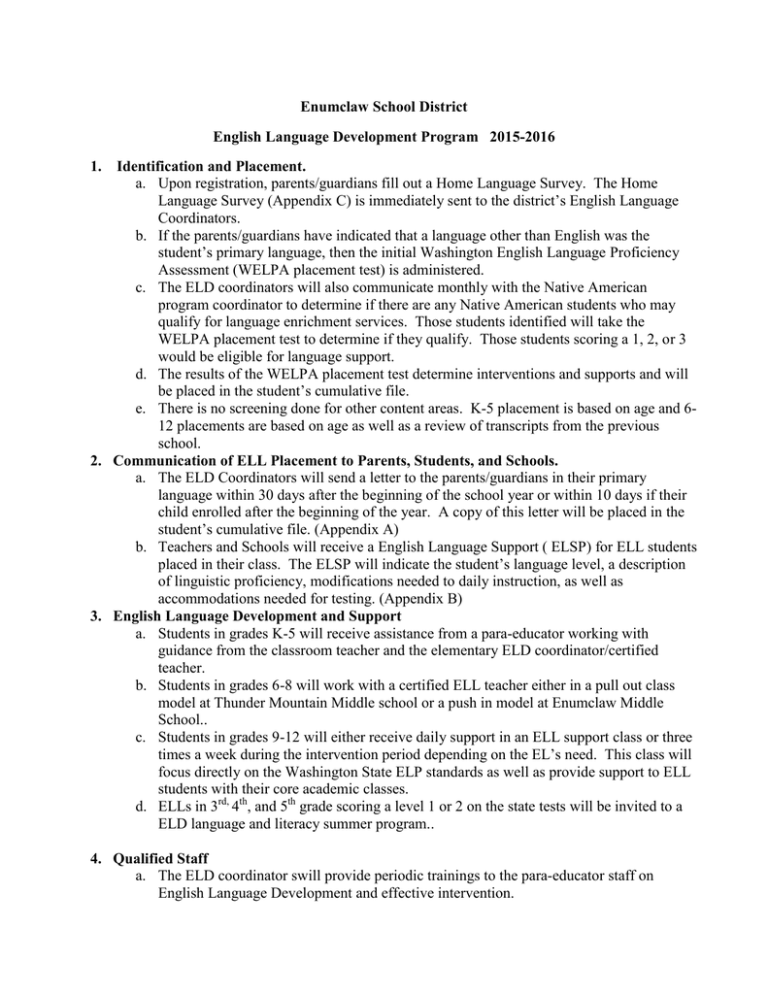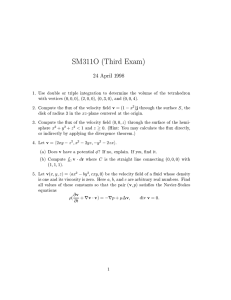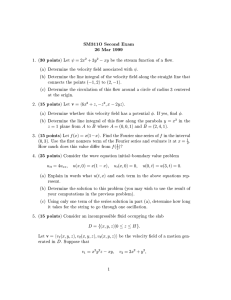Enumclaw School District English Language Development Program 2015-2016
advertisement

Enumclaw School District English Language Development Program 2015-2016 1. Identification and Placement. a. Upon registration, parents/guardians fill out a Home Language Survey. The Home Language Survey (Appendix C) is immediately sent to the district’s English Language Coordinators. b. If the parents/guardians have indicated that a language other than English was the student’s primary language, then the initial Washington English Language Proficiency Assessment (WELPA placement test) is administered. c. The ELD coordinators will also communicate monthly with the Native American program coordinator to determine if there are any Native American students who may qualify for language enrichment services. Those students identified will take the WELPA placement test to determine if they qualify. Those students scoring a 1, 2, or 3 would be eligible for language support. d. The results of the WELPA placement test determine interventions and supports and will be placed in the student’s cumulative file. e. There is no screening done for other content areas. K-5 placement is based on age and 612 placements are based on age as well as a review of transcripts from the previous school. 2. Communication of ELL Placement to Parents, Students, and Schools. a. The ELD Coordinators will send a letter to the parents/guardians in their primary language within 30 days after the beginning of the school year or within 10 days if their child enrolled after the beginning of the year. A copy of this letter will be placed in the student’s cumulative file. (Appendix A) b. Teachers and Schools will receive a English Language Support ( ELSP) for ELL students placed in their class. The ELSP will indicate the student’s language level, a description of linguistic proficiency, modifications needed to daily instruction, as well as accommodations needed for testing. (Appendix B) 3. English Language Development and Support a. Students in grades K-5 will receive assistance from a para-educator working with guidance from the classroom teacher and the elementary ELD coordinator/certified teacher. b. Students in grades 6-8 will work with a certified ELL teacher either in a pull out class model at Thunder Mountain Middle school or a push in model at Enumclaw Middle School.. c. Students in grades 9-12 will either receive daily support in an ELL support class or three times a week during the intervention period depending on the EL’s need. This class will focus directly on the Washington State ELP standards as well as provide support to ELL students with their core academic classes. d. ELLs in 3rd, 4th, and 5th grade scoring a level 1 or 2 on the state tests will be invited to a ELD language and literacy summer program.. 4. Qualified Staff a. The ELD coordinator swill provide periodic trainings to the para-educator staff on English Language Development and effective intervention. b. The ELD coordinator will communicate with classroom teachers, as well as act as a resource and coach to classroom teachers to ensure that ELLs in their class can access the instruction. c. All classroom teachers will understand their responsibility to ensure these students can access the instruction. d. The ELD coordinator will provide opportunities for professional development for learning and implementing best practices for instruction of ELLs. 5. System for Determining whether ELL’s are making progress. a. The ELD coordinator will use the WELPA to determine if students are making annual progress in regards to English Language Development. b. The Smarter Balance results will be used to determine progress in Reading, writing, math and science for students in grades 3-12. c. The DRA and district CBA’s, along will be used to monitor students and determine progress on a quarterly bases in the elementary schools and periodic grade checks through Skyward will determine progress at the secondary schools. 6. Monitoring Transitional Students a. Students who receive a comprehensive score of 4 on the WELPA annual exam will transition out of the ELD program. b. Transitional ELL Students will be monitored every two months through direct communication with the classroom teacher and grade checks on Skyward. When concerns arise, the ELD coordinators will work with teachers and principals to determine appropriate interventions. 7. System to Ensure ELLs have access same programs and services as all other students. a. The ELD coordinator will work with parents and teachers and students to ensure equal access to AP classes and gifted programs b. The ELD coordinator will work with principals, parents, and students to ensure equal access to extracurricular programs. c. The district will provide information of special programs and services in Spanish whenever feasibly possible. 8. System in Place to Support ELLs in Graduating and Accessing Post-Secondary Options a. The high school counselors will consult and work with the ELD coordinator to review credits awarded for secondary work completed in other countries. b. The high school counselors and the ELD coordinator will work together to monitor ELL’s progress towards graduating. c. ELLs will be assisted with information about applying to college, technical training and other post-secondary options during their ELD support class. 9. Parent Outreach and Involvement in Program Planning Process a. The Hispanic Parent Advocacy Committee (HPAC) meets three times a year as a general meeting and four times a year with the leaders of this group. b. Communications of important events are released in both Spanish and English. . Title III Parent Notification of Student Placement English Language Development Program Child’s Name: ________________________________________ Date:___________________________ School: _______________________________ School District: ________________________________ Enrollment Status: ____ New to the program ____ Continuing in the program Dear Parent or Guardian, I am pleased to inform you that your child will receive additional support through an English language development program for the 2015-2016 school year. The district identified your child as being limited English proficient through test results. Your child’s proficiency in English measured at Level I: ___, Level II: ___, Level III: ___ on the Washington English Language Proficiency Assessment (Placement Test) (WELPA). The purpose of the program is to provide additional support for students not yet proficient in speaking, listening, reading and writing in English. The program will assist your child to meet age appropriate academic achievement standards for grade promotion and graduation. Students remain eligible for the English language development program until they score a Level IV on the annual Washington English Language Proficiency Assessment (WELPA). Most students successfully exit the program within 5-7 years. When exited from the program, your child’s performance will continue to be monitored to determine if future assistance is needed. If your child has a disability, the English language development program will coordinate with appropriate staff to meet the objectives of your child’s Individualized Education or 504 Plan. I strongly encourage your child’s participation in the English language development program and invite you to learn more about the benefits of the program. However, you have the right to remove your child from the language instruction program at any time. Please visit our school to discuss your child’s progress in English language development and academic achievement. Contact Kim Hatzenbeler at (360)802-7105 if you wish to set up an appointment. Your child is enrolled in the following English language development program(s) Appendix A The school district has the following English language development program(s): ____ Dual Language Program: Dual language programs provide integrated language and academic instruction for native English and native speakers of another language with the goals of high academic achievement, first and second language proficiency, and cross-cultural understanding (Christian, 1994). ____ Developmental Bilingual Education (Late-Exit): Developmental bilingual education (DBE), also referred to as late-exit bilingual education (Ramirez, 1992), educates English language learners using both English and their first language for academic instruction. DBE programs aim to promote high levels of academic achievement in all curricular areas and full academic language proficiency in the students' first and second languages. ____ Transitional Bilingual Education (Early-Exit): Transitional bilingual education (TBE) – also known as early-exit bilingual education (Ramirez, 1992) provides academic instruction in English language learners' primary language as they learn English. __X_ Sheltered Instruction (Content-Based ESL): Sheltered Instruction is an approach for teaching content to English language learners (ELLs) in strategic ways that make academic subject matter concepts comprehensible while promoting the students' English language development. (Echevarria, J., Vogt M.-E., & Short, D., 2000) ____ Newcomer Program: Newcomer programs help students to acquire beginning English language skills along with core academic skills and knowledge, and to acculturate to the U.S. school system. Sincerely, Kim Hatzenbeler ELD Program Coordinator Enumclaw School District (360)802-7105 Appendix A cont. EL Support Plan for Proficiency Level 1b:2nd & 3rd Grade School Year 2014-2015 STUDENT INFORMATION Name Home Language ELD Program Entry Date Grade Level 3 Teacher/Team Proficiency Level at Entry Proficiency Level 1b L2 CLASSROOM IMPLICATIONS: Recommended Instructional Recommended Recommended Strategies Accommodations Modifications Explicit vocabulary instruction and Use assistive technology Have student rephrase directions practice (frontloading, repetition) Read aloud/rephrase difficult Provide visual support Visual support and modeling words, phrases, idioms on tests Allow language errors when assessing content Link concepts to personal and Cooperative learning academic background Additional time to complete tasks Slow the pace of instruction Extensive oral language practice Opportunity to revise/redo Chunk tasks and/or give an outline Thinking Maps for an assignment Opportunity to show Sentence frames understanding in multiple modes Adapted texts Tiered questioning BREAK DOWN OF LEVELS WELPA ADDITIONAL SERVICES Speaking – Listening – ReadingWriting- Special Education Migrant Speech/Language Therapy 504 Plan Other: ______________________________________ DESCRIPTION OF PROFICIENCY LEVEL Receptive Language Productive Language Interactive Language (Listening/Reading) ELP standard 1,8 9*(speaking/writing) (Speaking and writing) (Collaborative use or reading/writing/speaking/listening) ELP Standards 2, 5, 6 ELP standards 3,4,7,10 • identify some key words and phrases • identify the main topic or message/lesson • deliver simple oral presentations • compose written texts • ask and answer questions about the meaning of frequently occurring words, phrases, and expressions • express an opinion * communicate simple information about a topic * recount two events in sequence * use frequently occurring linking words (e.g., and, then) with emerging control. • show increasing awareness of differences between informal “playground” speech and language appropriate to the classroom • use some words learned through conversations, reading, and being read to. • recognize and use some frequently occurring collective nouns (e.g. group) • use frequently occurring verbs, adjectives, adverbs, and conjunctions • produce simple sentences in response to prompts. • participate in short conversations, discussions, and written exchanges • take turns • respond to simple yes/no and whquestions • carry out short individual or shared research projects • recall information from experience • gather information from provided sources • record some information/observations in simple notes • identify a reason an author or a speaker gives to support the main point. : FOR MORE DETAILS ON STANDARDS GO TO HTTPS://WWW.K12.WA.US/MIGRANTBILINGUAL/PUBDOCS/ELP/WA-ELP-STANDARDS-K12.PDF APPENDIX B ASSESSMENT ACCOMMODATIONS – review prior to assessment to ensure these are still appropriate Presentation Read-Aloud: Human Readers and ReadAloud CDs ** Test in Small group Read-Aloud: Translated Presentations*** Response Spell Check/Word Prediction Software*** Grammar Devices** *** Voice Recognition Software: Speechto-Text*** Scribes*** Other Student has IEP or 504 – see plan for more accommodations MSP Math or Math/Science only ___________________________ English Glossaries** *** ** Content-specific restrictions apply *** Not available on WELPA See: http://www.k12.wa.us/assessment/alternativeassessment/pubdocs/AccommodationManual.pdf Appendix B cont. Office of Superintendent of Public Instruction (OSPI) Home Language Survey Student Name: Birth Date: Date: Gender: Grade: Form Completed by: Parent/Guardian Name Relationship to Student Parent/Guardian Signature If available, in what language would you prefer to receive communication from the school? Did your child receive English language development support through the Transitional Bilingual Instruction Program in the last school your child attended? Yes__ No__ Don’t Know__ 1. In what country was your child born? ____________________ 2. What language did your child first learn to speak?* __________________ 3. What language does YOUR CHILD use the most at home?* ____________________ 4. What language(s) do parent/guardians use the most when you speak to your child? _____________________ _____________________ 5. Has your child ever received formal education* outside of the United States? If yes, in what language(s) was instruction given? _____________________ For how many months? ____ (Kindergarten – 12th grade) _____Yes _____No ”Formal education” does not include refugee camps or other unaccredited programs for children. 6. When did your child first attend a school in the United States? 7. Do grandparent(s) or parent(s) have a Native American tribal affiliation? _____Yes _____No Appendix C (Kindergarten – 12th grade) _______________________ Month Day Year *WAC 392-160-005: "Primary language" means the language most often used by a student (not necessarily by parents, guardians, or others) for communication in the student's place of residence. Note to district: A response of a language other than English to question #2 OR question #3 triggers ELL placement testing The Purpose of the Home Language Survey The Home Language Survey is given to all students enrolling in Washington schools. The following information should help answer some of the questions you may have about this form. What is the purpose of the Home Language Survey? The primary purpose of the Home Language Survey is to help identify students who may qualify for support to help them develop the English language skills necessary for success in the classroom and who may qualify for other services. It is important that this information be correctly recorded since it can affect the eligibility of students for services they need to be successful in school. Testing may be necessary to determine whether or not additional language and academic supports are needed. No student will be placed in an English language development program based solely on responses to this form. Why do you ask about the student’s first language and language(s) used in the home? The two questions about the student’s language help us to determine: if your student may be eligible for assistance with learning English, and whether staff at the school should be aware of other languages being used by the student at home. The language your child first learned may be different from the language your child uses for communication at home now. The responses to both of these questions will assist the school in providing instruction appropriate to the individual student’s needs as well as help with communication needs that may arise. Students who first learned a language other than English may qualify for additional supports. Even students who speak English well may still need support in developing the language skills needed to be successful in school. Why do you ask where the student was born? This information helps the school district and the state determine if the student meets the definition of immigrant for the purposes of federal funding. This applies even when the student’s parents are both US citizens, but the student was born outside of the United States. This form is not used to identify students who may be undocumented. Why do you ask about my student’s previous education? Information about a student’s education will help ensure that the student’s education both within and outside of the United States is considered in any recommendations made for participation in programs and district services. The student’s educational background is also important information to help determine if the student is making adequate progress toward state standards based on their prior educational background. Thank you for providing the information needed on the Home Language Survey. Contact your school district if you have further questions about this form or about services available at your child’s school. Appendix C cont.






